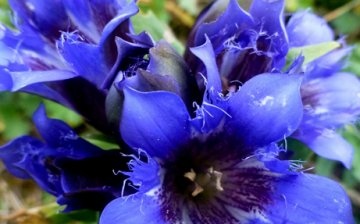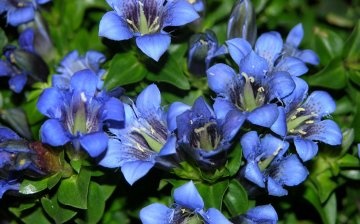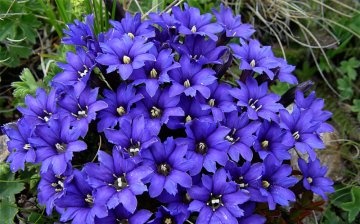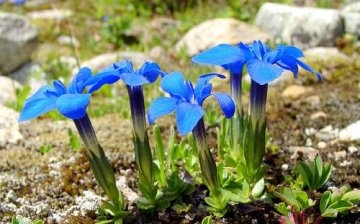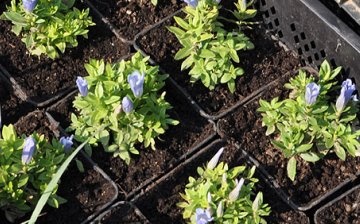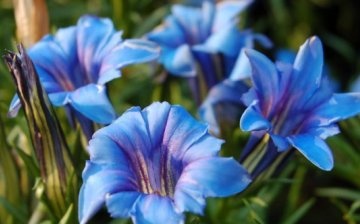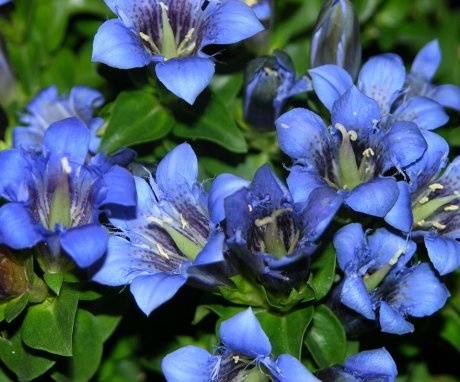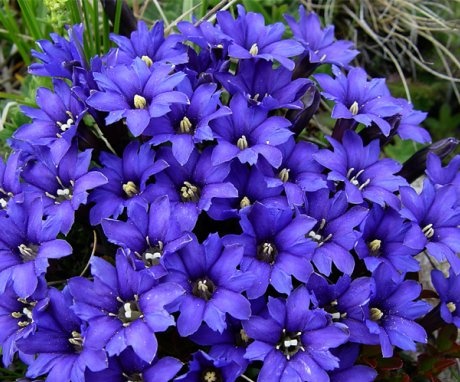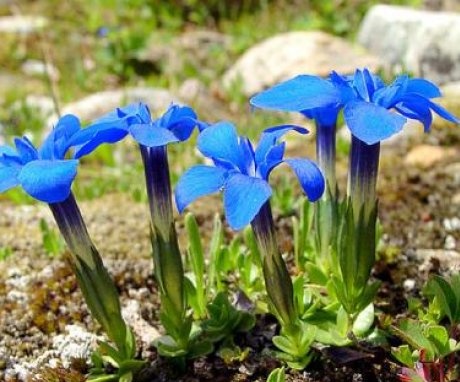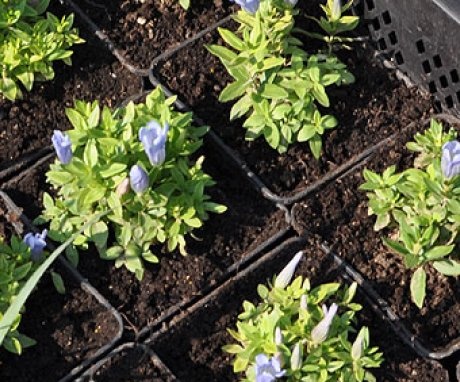Gentian - decor of a modern garden: proper planting and care
Gentian - this is a beauty of the Alpine mountains, it blooms with beautiful large flowers of delicate shades and adorns the surrounding area for a long time. In flower beds and summer cottages, such a plant can rarely be found, mostly few have heard of it. Those who are familiar with this flower talk about the difficulty of caring for it. In fact, caring for a gentian is quite simple, and it will give flowers almost all season, pleasing the eye and decorating the site.
Content:
Features of gentian
Gentian is a herbaceous plant that belongs to the gentian family. More than 400 species of these flowers can be found in nature; only about 100 varieties are grown in culture. The name gentian is common only in Russian-speaking regions, it is associated with the bitter taste of roots and leaves, the Latin name of the plant Gentiana. The homeland of the plant is the territory of the Alps, but today it is found on almost all continents of the planet, except for Africa.
Depending on the type, gentian can grow in the form of a small herbaceous plant or a tall, up to 2 meters, bush.
The stems are powerful, thick. Flowers are formed at the tops of the branches mainly singly, sometimes 2-3 in a bunch. Most of the petals are colored in shades of blue and light blue, but there are also yellow, pink and white.
Ovate leaves are oppositely located on the stems. Root system consists of one powerful rod that goes deep into the ground. Period flowering different varieties differ, so if you choose the right seeds, the flower bed will delight you throughout the season.
Care
For good development and flowering gentian is recommended to select warm and well-lit places. Some varieties grow well in the shade, but do not feel good in the sun. The best option would be penumbra areas, where the plant will receive enough light and at the same time not overheat.
Soil requirements vary from cultivar to cultivar, some like acidic soils, others prefer neutral ones.
The main thing is that the soil is loose, it allows air to pass through well and does not retain water.
It is not necessary to plant the plant on fertile soil, since in nature the gentian lives in poor areas. For the same reasons, there is no annual feeding.
Watering the plant:
- Gentian is not demanding for watering, but it is necessary to moisten the soil regularly. This is especially important during the period when buds are forming and developing.
- After an abundant glaze and rains, it is recommended to loosen the soil each time to stimulate the free passage of water into the soil.
- Any stagnation can provoke root rot, and the plant can die.
For tall varieties of gentian, pruning dry and faded branches. For the rest, decorativeness is maintained by removing wilted buds and dried leaves.
Landing
The gentian is planted in open ground in the spring or in the autumn for the winter. For each seedling, it is necessary to prepare its own hole at a distance of 15-30 cm from each other, depending on the size of the future plant.
After planting, the gentian can not be disturbed for 5-7 years, it develops well and grows for a long time in the same place.
Care for young plantings is practically the same as for adult plants. Timely watering, loosening the soil and removing weeds give the gentian enough strength and energy for an annual abundant flowering.
Reproduction
Gentian reproduces with the help seed, cuttings and dividing the bush. Seeds sown in the autumn in open ground. This is done to ensure that the seedlings go through the process of natural stratification... They are not afraid of frost and hatch the next year, mainly 7 months after sowing. Such seedlings will give abundant flowering only after a year.
You can also grow from seeds seedlings in room conditions, if there is a balcony or loggia, on which the temperature is in the range of -5- + 5 degrees.
Planting seeds for seedlings:
Pre-prepared soil is laid out in the container. The substrate is prepared from equal proportions of peat and sand and pre-steamed.
- When the prepared warm soil is tightly packed in containers, it must be watered with boiled water.
- Next, gently sow the seeds and cover them with a thin layer of the same substrate.
- The container is covered with glass or foil.
- Crops are regularly moistened with a spray bottle, and after 1.5 weeks are placed in the refrigerator for 20-25 days. After this period, the container is taken out to the balcony for 2 months, after which it is transferred to a warm and bright place.
- After a while, seedlings will appear, if necessary, it is recommended to add additional artificial lighting.
- Crops are watered regularly, the substrate should not completely dry out. Before planting seedlings, the soil is watered abundantly.
- Each plant is taken separately, carefully together with an earthen clod, so as not to damage the root system.
Reproduce cuttings only some varieties of gentian. At the same time, an appendage is formed on the mother bush, which, after separation, is immediately planted in a prepared substrate for rooting. The substrate is prepared in advance, and the seedling is regularly moistened and the earth is loosened in the container or in the area around it and weeds are removed.
Reproduction by dividing the bush is carried out during the period transplants plants, while one bush can be divided into 5-7 depending on the size and age of the plant. The resulting seedlings can be planted in open ground on the same day, flowering will be next year.
All types of gentian are resistant to diseases and pests.
Most of the time, problems can begin if care is not taken properly. For example, when humidity is constant, slugs and snails can appear. This can be easily remedied by giving the soil around the plant time to dry out.
Application
The gentian is mainly used as an ornamental plant. With the right selection of varieties and combined planting, you can get continuously blooming flower bed... To compose compositions, it is recommended to select plants of the same height so that no additional shadow is created. Autumn varieties are demanding on air humidity, they are recommended to be planted near an artificial lake or pond on the site.
For low-growing varieties, a planting in the form of a solid carpet looks beautiful.
Tall bushes can be beautifully combined to create vibrant multi-colored bouquets. In addition to decorative use, gentian is used for medicinal purposes. Even in ancient times, tinctures were prepared from it for the treatment of cough, inflammation, and was also used as a tonic.
More information can be found in the video.



